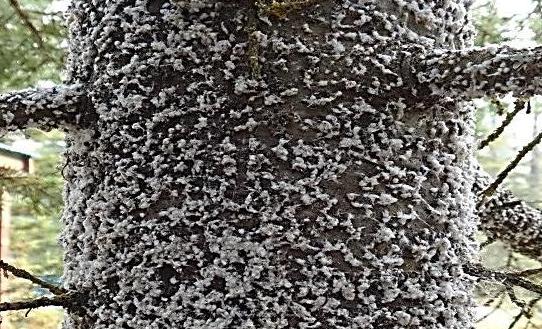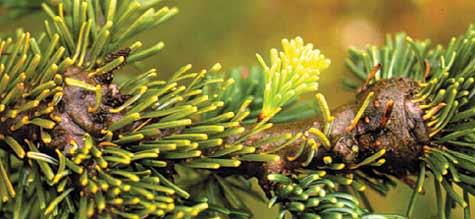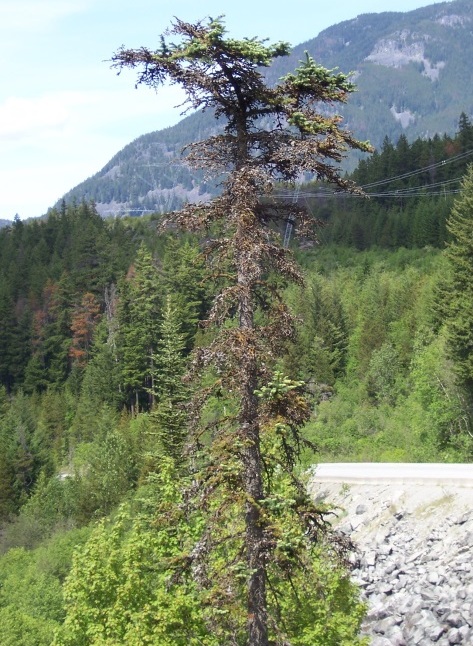Balsam woolly adelgid
The balsam woolly adelgid, Adelges piceae (Ratz.), was accidentally introduced into North America from Europe. It feeds on all true firs (Abies spp.). The most susceptible species of true fir in B.C. is subalpine fir (A. lasiocarpa).
On this page
Balsam woolly adelgid is an important pest of true firs in B.C., the Atlantic Provinces, and the northeast and northwest United States. A provincial regulation has restricted the movement of true firs within B.C. with the intent to reduce the risk of balsam woolly adelgid spreading into the Interior of the province. However, recent surveys (as of 2018) have indicated that balsam woolly adelgid has spread into the interior of B.C. (confirmed as far north as Horsefly and east to Nelson, B.C.).
Signs and symptoms
These insects are inconspicuous, aphid-like pests that are approximately 1 mm long on the bark and can be easily overlooked in the early stages of infestation due to their size. However, despite their size, they can damage or kill a tree after several years of heavy feeding. To feed, the adelgids inject their mouthparts into the phloem of the tree causing abnormal cell development which restricts fluid transport in the tree, and causes thickening of wood cells and inhibits bud formation.

Balsam woolly adelgid white, woolly tufts that may be visible on the bole of infested fir trees.
Symptoms of balsam woolly adelgid infestations include:
- Yellowing and premature needle loss
- Swelling of branch nodes and terminal buds (gouting)
- Top deformation or top kill

Balsam woolly adelgid gouting symptoms on a fir branch.

Balsam woolly adelgid impacted fir tree with a characteristic flattened top and declining health.
Life cycle
Balsam woolly adelgids have two to four generations per year. The wingless female can produce in excess of 200 amber colored eggs. The eggs are laid under the visible white, woolly tufts on the bark of the tree bole or on branches. Crawlers are visible with the aid of a hand lens beginning around bud break. There are no males and females give rise to more females.
Regulations and management
The movement of true firs for use in reforestation, or as an ornamental or a Christmas tree, posed a significant risk of spreading this pest. To reduce this risk, all true firs have been grown under permit. Annual permits expire annually on December 31st and can be obtained from the Entomologist with the British Columbia Ministry of Agriculture in Abbotsford, B.C.
View the current provincial and federal regulations designed to limit the spread of BWA.
Trees grown outside the quarantine zone have had free movement within the province (BWA Quarantine Zone Map (GIF, 23KB)). True firs grown in the quarantine zone cannot be shipped outside the zone within the province. There are no restrictions on the domestic movement of true firs outside of the province. Sale and movement of cut trees or foliage of true firs grown in the quarantine zone is prohibited between January 31 and November 1 anywhere in the province. Cones and seeds are exempt from this regulation. When moved between November 1 and January 31, cut Christmas trees, boughs for wreaths or decorations, and cones are also exempt from zone restrictions.
Considering the balsam woolly adelgid has now become established in the Interior of the province, deregulation will include the removal of the quarantine zone and growers will no longer require a permit to grow true fir species. Deregulation is expected to be in place by March 31, 2019.
There are no effective, naturally occurring biological control agents for balsam woolly adelgid in the province. Control includes removal and disposal of infested trees. Insecticides may have only limited impact, however efficacy trials are underway.
Canadian Forest Service information
Contact information
Contact us if you have further questions about gypsy moths and how they are controlled in B.C.
